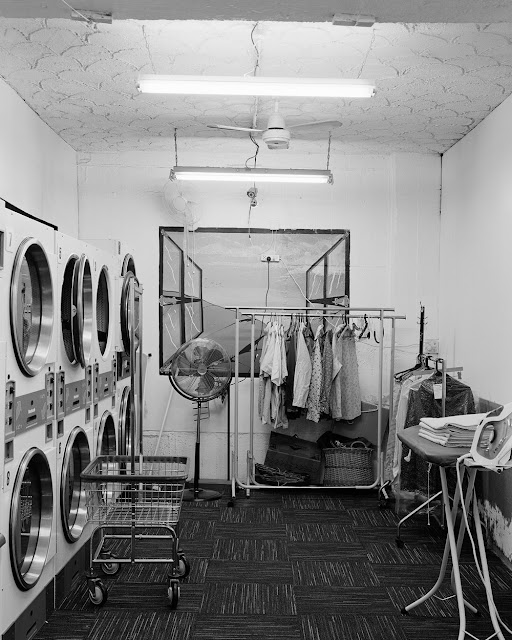 |
Mirror City. By Harry Culy.
|
Photographs by Harry Culy
Bad News Books, 2023. 100 pp., 58 duotone plates, 8x10".
For photographers shooting hometowns, acquaintance is a constant hazard. It can be hard to get a clear-eyed view of a place from within. Sometimes you’re better off putting some distance between yourself and the target. Even if the material is the same, the exterior view is different. Familiar subjects assume a fresh veneer: clean, objective, and unfiltered. At least in theory.
Harry Culy’s debut photobook puts this hypothesis to the test. Mirror City collects Culy’s b/w photographs shot upon his return to Te Whanganui-a-Tara (Wellington), after ten years away. Growing up in the New Zealand capital decades earlier, he had come to know the place quite well. He’d explored the underbelly and skateboarded its sidewalks. He’d formed a sense of what it was to be a resident. He’d even made photographs of the city.
But those were inside views from a previous time. The key that unlocked Mirror City was foreign travel. Upon returning to his old hometown, he saw everything with fresh eyes. “On my return, I encountered an eerie feeling — 'home' felt strangely unfamiliar,” he described the lightbulb moment in a recent interview. “When I came back I realized that New Zealand is actually a pretty strange and amazing place.”
 |
From 2019 through 2022, he photographed in and around the city, working intuitively. “Pretty much all my work comes from places and people I have personal connection to,” he says. “Moving through the city I made pictures of anything that caught my attention.” He photographed local friends, structures, and lyric documentary scenes using a 4 x 5 view camera, later making silver gelatin prints in a darkroom. As if that didn’t keep him busy enough, he also co-founded a publishing company. These disparate life strands come together in Mirror City, a “kind of gothic love letter to my hometown” which is published by Culy’s own Bad News Books.
 |
 |
This isn’t just any type of gothic letter. It’s Antipodean gothic, a version particular to New Zealand and Australia. The south island nations foster a sense of isolation and removal all their own, reflected in films, photo, and visual culture. Day is night. The southern heavens are literally star crossed. Heck, even their seasons are backward. “It’s a feeling of being unsettled,” says Culy, “of uneasiness, anxiety, which is kind of simultaneously pleasurable and not at the same time.” Throw in a global pandemic, and Mirror City takes on a broody edginess. Photographs of spider webs and wrought iron fencing hint at unconscious restrictions while Satanic symbols, spray painted phrases, and graffitied carvings might be Antipodean iconography. Abandoned ephemera and underground symbols seem commonplace in Te Whanganui-a-Tara, a city which feels closer to smallish exurb than metropolis, at least as photographed by Culy.
 |
These visual dust ups are just the leading edge of wider disruptions. Culy is continually drawn to broken forms. He photographs discarded lumber in a heap, smashed windows, barbed wire, twisted antennae, and melting candles, all possessing a certain photographic charms. As the title hints, there are even a few mirrors in the mix. As formal compositions all are well seen. They’re aesthetically pleasing enough. But taken collectively they convey a downcast mood. Perhaps this is the aforementioned Antipodean gothic, or the years-long residue of Culy’s jet lag? Hard to say. In any case, Mirror City’s ugly backdrops form a sharp contrast with its human subjects. All are young and sensual, captured in situ on city streets. Some radiate a pure beauty which is near otherworldly. They might easily be cast in a film or lifestyle magazine. One wonders if Culy sees himself reflected in them, or perhaps his artistic soul is in junkyard glass.
 |
Culy offers clues in the form of text excerpts. These are written in silver on black pages, then interspersed here and there with his monochromes. He shares shopping lists, notes to self, iPhone ramblings, movie titles, board games, and other scattered snippets. If they don’t make much literal sense, that’s not really the point. They operate on the subconscious as dream-like suggestions. These phrases get into the reader’s mind and float in the cranial soup alongside Culy’s pictures. It’s a pleasing enough effect, similar in some ways to the disrupted logic of foreign travel or urbex photography. Ideally these materials might combine into a mirror held up to the self, or to one’s home city.
Purchase Book
 |
 |
 |
Blake Andrews is a photographer based in Eugene, OR. He writes about photography at blakeandrews.blogspot.com.









